Monitor "PCSV" parameter on the scantool.
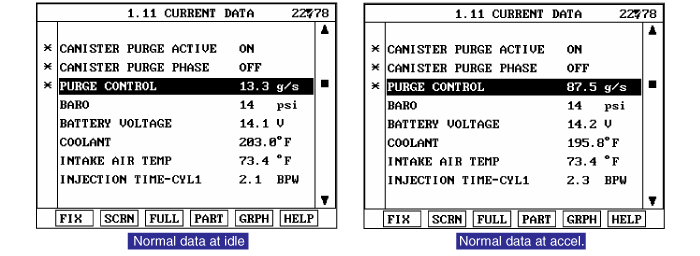

The purge solenoid is a pneumatic device that meters the air and fuel (purge) vapor flow to thepurge port. In a sense, the purge solenoid is comparable to a fuel injector, because the meteredpurge flow follows the same slope and offset characteristics. However, the purge solenoidnormally runs with a duty cycle at a fixed frequency because the opening response is significantly slower than a fuel injector. It would not practical to run the solenoid synchronouslywith engine events except perhaps at very low RPM. The normal frequencies for the purgesolenoid are between 8 and 20 Hz.
Checking output signals from PCSV every 10 sec. under detecting condition, if signals indicating open or short to ground in the circuit are detected for more than 5 sec., PCM sets P0444. MIL(Malfunction Indication Lamp) turns on when the malfunction lasts till consecutive 2 driving cycle.
Item | Detecting Condition | Possible cause |
DTC Strategy | ● Open, short to ground | ● Poor connection ● Open or short to ground in harness ● PCSV ● PCM |
EnableConditions | ● Engine running state ● 11V ≤ Battery voltage ≤ 16V ● Above enable conditions are met > 0.5 sec. | |
Threshold value | ● Open or short to ground | |
DiagnosisTime | ● Continuous (More than 5 sec.failure for every 10 sec.test) | |
MIL On Condition | ● 2 driving cycles |

Item | Coil resistance(Ω) |
PCSV | 19.0 ~ 22.0Ω (at 20℃ / 68℉) |

Connect scantool to Data Link Connector (DLC)
Warm up engine to normal operating temperature.
Monitor "PCSV" parameter on the scantool.

Is the current data displayed correctly?

▶ Fault is intermittently caused by poor contact in the sensor and/or PCM connector or non cleared PCM memory after repair. Thoroughly check connectors for looseness, poor connection, bending, corrosion, contamination, deterioration, or damage. Repair or replace if necessary and go to "Verification of vehicle Repair".

▶ Go to "Terminal and Connector Inspection" procedure.
Many malfunctions in the electrical system are caused by poor harness and terminals. Faults can also be caused by interference from other electrical systems, and mechanical or chemical damage.
Thoroughly check connectors for looseness, poor connection, bending, corrosion, contamination, deterioration, or damage.
Has a problem been found?

▶ Repair as necessary and go to "Verification of Vehicle Repair" procedure

▶ Go to " Power Circuit Inspection " procedure.
IG "OFF" and disconnect PCSV connector.
IG "ON" and ENG "OFF"
Measure voltage between terminal 1 of PCSV harness connector and chassis ground.
Specification : B+
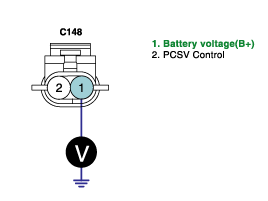
Is the measured voltage within specification?

▶ Go to "Control Circuit Inspection" procedure.

▶ Repair open or short to ground in harness, and go to " Verification of Vehicle Repair" procedure.
Check short to ground in harness.
IG "OFF" and disconnect PCSV connector.
IG "ON"
Measure voltage between terminal 2 of PCSV harness connector and chassis ground.
Specification : Approx. 0.5V
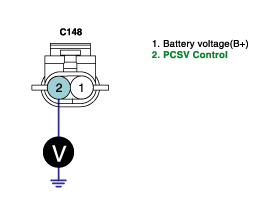
Is the measured voltage within specification?

▶ Go to "Check open in harness" as follows.

▶ Repair short to ground in harness, and go to " Verification of Vehicle Repair" procedure.
Check open in harness.
IG "OFF" and disconnect PCSV connector and PCM connector.
Measure resistance between terminal 2 of PCSV harness connector and terminal 78 of PCM harness connector.
Specification : Below 1Ω
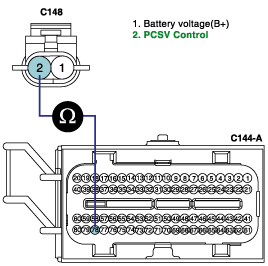
Is the measured resistance within specification?

▶ Go to " Component Inspection" procedure.

▶ Repair open in harness, and go to "Verification of Vehicle Repair" procedure.
Check PCSV
IG "OFF" and disconnect PCSV connector.
Measure resistance between terminals 1 and 2 of PCSV connector.(Component side)
Item | Coil resistance(Ω) |
PCSV | 19.0 ~ 22.0Ω (at 20℃ / 68℉) |
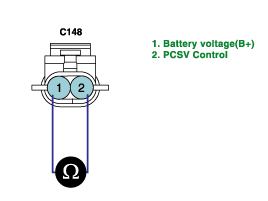
Is the measured resistance within specification?

▶ Substitute with a known - good PCM and check for proper operation.
▶ If the problem is corrected, replace PCM and go to "Verification of Vehicle Repair" procedure.

▶ Substitute with a known - good PCSV and check for proper operation.
▶ If the problem is corrected, replace PCSV and go to "Verification of Vehicle Repair" procedure.
There is a memory reset function on scantool that can erase optional parts automatically detected and memorized by PCM. After testing PCM on the vehicle, use this function to reuse the PCM on the others
After a repair, it is essential to verify that the fault has been corrected.
Monitor and record the Freeze Frame Data for the Diagnostic Trouble Code(DTC) which has been diagnosed.
Using a Scantool, Clear the DTCs
Operate the vehicle within conditions noted in the freeze frame data or enable conditions
Monitor that all rediness test have been verified as " Complete "
Are any DTCs present ?

▶ Go to the applicable troubleshoooting procedure.

▶ System is performing to specification at this time.